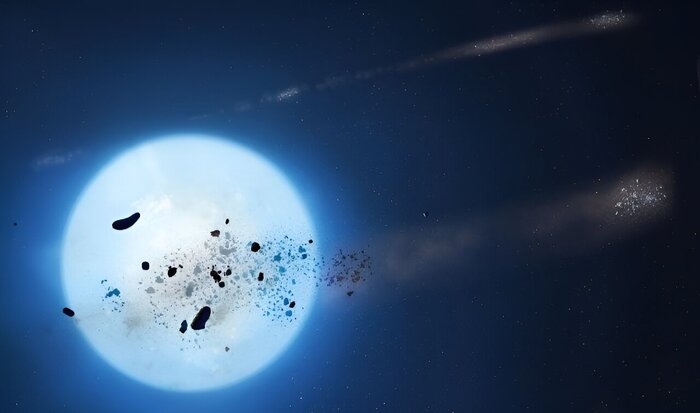Radiation effects of the Chernobyl accident study 0:43
(CNN) -
When photographer David McMillan first visited the city of Pripyat in 1994, he expected his movements to be restricted.
Just eight years earlier, a reactor at the nearby Chernobyl nuclear power plant had exploded, forcing an evacuation across the region and sending radioactive fallout across Europe.
However, the photographer was not only free to roam the 1,600-square-kilometer Chernobyl Exclusion Zone, which remains largely uninhabited to this day, but was able to get within yards of the damaged reactor.
“The challenge was finding people who could get me in,” he recalled in a 2019 telephone interview. “I didn't know where to go;
I was at the mercy of the drivers and my interpreter.
I had no real sense (of danger), "he added."
People just advised me that some areas were heavily polluted and that maybe I should take just a minute or two to photograph there.
advertising
This initial journey resulted in a series of eerie images documenting abandoned buildings, playgrounds, and abandoned vehicles after the cleanup.
It also sparked a curiosity that, over the next quarter century, would bring the Canadian photographer back to the region more than 20 times.
PHOTOS | Chernobyl Tourism: This is how air tours explore the worst nuclear catastrophe in history
200 of his photos were published in the book,
Growth and Decline: Pripyat and the Chernobyl Exclusion Zone
.
They provide a striking look at a ghost town largely intact from the disaster, while exploring the enduring power of nature and the inevitability of decline.
Chernobyl: remains of an 'exhibition' city
Pripyat, in present-day Ukraine, was part of the Soviet Union at the time of the catastrophe in April 1986. Built in the previous decade to serve the power plant and its workers, the city was home to around 50,000 people. .
"It must have been beautiful," said McMillan, who studied archival footage of the area.
“At that time, it was considered one of the best cities to live in the Soviet Union.
There were many schools and hospitals and facilities for sports and culture, so it was an exhibition city.
McMillan photographed the same point multiple times.
These comforts are now abandoned, falling victim to decay, rust, and looting.
Many of McMillan's photos, whether they show empty swimming pools or deserted churches, reveal how suddenly the city was evacuated.
"In schools, it feels like the students left in the afternoon," he said.
"There were still teacher log books, textbooks, student artwork and things like that."
The buildings thus served as a kind of time capsules.
Images showing faded portraits of Marx and Engels or Lenin's bust in a neglected courtyard capture a particular moment in political history.
LOOK
: The president of Ukraine wants to give "a new life" to Chernobyl
But they also demonstrate the power of time.
In some cases, McMillan photographed the same location multiple times, over many years, to highlight the deterioration of the built environment.
One of the most powerful examples is a series of pictures taken on a kindergarten staircase.
The first, captured in 1994, depicts brightly colored flags of the former Soviet republics taped to a peeled wall.
At the time of the last photograph, taken in November 2018, only one remains, and it has been so damaged and discolored that it could not even be recognized.
If you see it, you wouldn't know what it was;
You wouldn't even know it could have been a representation of a flag, ”McMillan said.
"It struck me as a symbol of the way our own memory of the Soviet era is fading into history."
Photos of playgrounds and slides also provide pertinent symbols of the passage of time.
The children who once played there will now be in their 30s and 40s.
"Going to some of the kindergartens, where there were so many children's objects, and knowing that the incidence of thyroid cancer skyrocketed because of the accident, it triggered a different kind of (emotional response)."
"But it probably also triggered an inevitable, and I resist saying this, beauty (of decadence)," he added.
"I have discovered that the walls have matured."
Nature returns to Chernobyl
As the title of his book,
Growth and Decline
,
suggests
, McMillan is concerned as much about the withdrawal of humanity as it is about the reappearance of nature.
The landscapes in his photos, while bleak, feature flowering plants and trees bursting through man-made structures.
"People weren't around, and when nature wasn't being cut down and cultivated, it just went wild and recovered itself," said the photographer.
"I suppose it was encouraging to see this kind of growth, and inevitable to see culture disappear."
"There has been a restocking of animals and someone even told me that bird watching is one of the best in Europe."
Chernobyl, a ghost town full of tourists
McMillan's images also show portraits of people he found in the Exclusion Zone, including engineers, workers and scientists who hunt wild animals to measure radiation in their organs.
One image, taken in 1995, shows a woman returning to her village to clean ancestral tombs.
Having met so many returnees, McMillan is relatively relaxed about the possible implications for his own health.
When I was 73 years old, I generally visited the place for at least a week at a time, which means that it has spent months, cumulatively, within the Chernobyl Exclusion Zone.
One of his original guides has contracted lymphoma since leaving Ukraine for Canada, although the photographer said it is unclear if the radiation is to blame.
"The thing about radiation is that it's intangible," McMillan said.
“When I brought a dosimeter with me once, (the radiation levels) were very irregular.
They were not the same throughout the Exclusion Zone, it is highly variable.
As pollution decreases with each passing year, so does the risk, the photographer explained.
A newly built "sarcophagus" (known as the Chernobyl New Safe Confinement) now encloses the reactor, replacing the temporary concrete envelope first built in 1986 to contain the aftermath.
Radiation effects of the Chernobyl accident study 0:43
"There are people who live in some (nearby) areas that are less polluted, so I've never worried," he said.
LOOK
: Vodka made in Chernobyl, would you dare to try it?
Now, a more real danger is that buildings will collapse.
Sometimes they seem delicate (and) when you go through them, you just don't know what might happen.
Editor's Note:
This story was originally published in 2019.
Chernobyl









